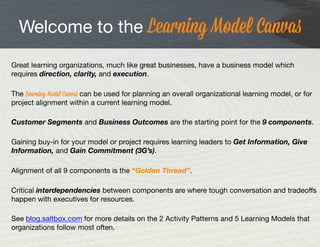lmc-interactive-15 Print
- 1. Great learning organizations, much like great businesses, have a business model which requires direction, clarity, and execution. The Learning Model Canvas can be used for planning an overall organizational learning model, or for project alignment within a current learning model. Customer Segments and Business Outcomes are the starting point for the 9 components. Gaining buy-in for your model or project requires learning leaders to Get Information, Give Information, and Gain Commitment (3G°Øs). Alignment of all 9 components is the °∞Golden Thread°±. Critical interdependencies between components are where tough conversation and tradeo?s happen with executives for resources. See blog.saltbox.com for more details on the 2 Activity Patterns and 5 Learning Models that organizations follow most often. Welcome to the Learning Model Canvas
- 2. www.businessmodelgeneration.com 3.0 Unported License. To view a copy of this license, visit http://creative- commons.org/licenses/by-sa/3.0/ or send a letter to Creative Commons, 171 Second Street, Suite 300, San Francisco, California, 94105, USA Key Partners Design Key Resources Value Proposition Delivery Customer Relationship Customer Segments Cost Structure Business Outcome Designed for: Designed by:
- 3. example... www.businessmodelgeneration.com 3.0 Unported License. To view a copy of this license, visit http://creative- commons.org/licenses/by-sa/3.0/ or send a letter to Creative Commons, 171 Second Street, Suite 300, San Francisco, California, 94105, USA Key Partners Design Key Resources Value Proposition Delivery Customer Relationship Customer Segments Cost Structure Business Outcome Who are the key partners for activities and resources? Examples: ? 3rd Party Content ? Application Developers ? System Integrators ? Vendors ? IT Department ? Executive Sponsors What is our value to our customers? Examples: ? Performance Support ? ? Risk Reduction ? Skills Development ? Information Dissemination ? Revenue Generation What groups or people are we creating value for? Examples: ? Business Units ? Employees ? Partners ? Company Customers Who is the real customer? ? Sponsor ? Requestor ? Payer ? Learner What key activities are needed for our value proposition? Examples: Types of Learning ? New Learning ? Continuing Education ? Critical Issues/Updates Production ? Ad Hoc/Agile/ADDIE ? Curate Structure ? Formal/Informal/Blended What type of relationship does each segment want? Examples: ? Strategic ? Vendor ? Broker ? Self-Service What key resources are needed to support the model? Examples: People ? Instructional Designers ? Community Managers ? Facilitators ? SMEs Tools ? Authoring ? Development ? Communication Systems ? Learning Record Store (LRS) ? ? Measurement & Reporting What delivery mechanisms work best for our customers? Examples: ? ? Mobile ? Content Management System ? Social Community ? LMS ? On-site ? One-to-one ? Email ? Webinar ? Intranet ? Instructional Designers ? Design Tools ? Delivery ? Systems ? Partners ? IT Development ? ? Efffectiveness ? Business Impact Put your Learning Model Canvas into motion. Contact John to discuss: john.delano@saltbox.com
- 5. 1-3 Get Information 4-6 Give Information 7-9 Gain Commitment °∞3G°Øs°± Selling with Learning Model Canvas






